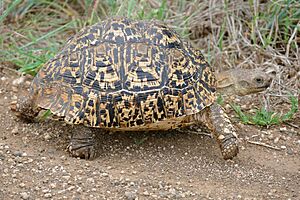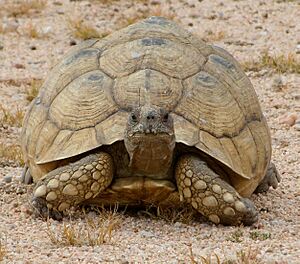Leopard tortoise facts for kids
Quick facts for kids Leopard tortoise |
|
|---|---|
 |
|
| On the S90 Road north of Satara, Kruger National Park, South Africa | |
| Conservation status | |
| Scientific classification | |
| Genus: |
Stigmochelys
|
| Species: |
pardalis
|
The leopard tortoise (Stigmochelys pardalis) is a very large and beautiful tortoise. You can find them in the savannas of eastern and southern Africa, from Sudan all the way down to the southern Cape Province. It's the only living member of its group, Stigmochelys.
These tortoises love to eat plants and live in dry, grassy areas. When the weather is super hot or super cold, they might hide in burrows dug by other animals like foxes or aardvarks. Leopard tortoises don't dig their own burrows, except when they need to make a nest for their eggs. They mostly munch on different kinds of grasses, but they also enjoy juicy succulents and thistles.
Contents
What's in a Name?
The leopard tortoise has a cool name that tells you a bit about it! The scientific name, Stigmochelys pardalis, comes from Greek and Latin words.
Stigma means "mark" or "point," and chelone means "tortoise." So, Stigmochelys means "marked tortoise." The second part, pardalis, comes from the Latin word pardus, which means "leopard." This refers to the awesome leopard-like spots you can see on the tortoise's shell, especially when they are young.
Scientists have changed their minds a few times about exactly where the leopard tortoise fits in the animal family tree. But now, most agree it belongs in its own special group called Stigmochelys.
Meet the Leopard Tortoise
The leopard tortoise is the fourth-largest type of tortoise in the whole world! Most adult tortoises are about 40 cm (16 in) long and weigh around 13 kg (29 lb).
In some parts of Africa, like the very north and south of their home range, these tortoises can grow even bigger. Some can weigh up to 20 kg (44 lb). An extra-large tortoise might even reach 70 cm (28 in) in length and weigh a massive 40 kg (88 lb)!
Their shell, called a carapace, is tall and shaped like a dome with sides that are almost straight up and down. Young tortoises have really pretty black spots, blotches, or even stripes on a bright yellow background. As they get older, these markings often fade to a plain brown or gray color. Their head and legs are usually a solid yellow, tan, or brown.
Where They Live and What They Like
Leopard tortoises live across many dry and grassy areas in eastern and southern Africa. You can find them from South Sudan and Somalia, all the way through East Africa, down to South Africa and Namibia. They usually don't live in the wet forest areas of Central Africa.
These tortoises are very adaptable! They live in many different places, including grasslands, thorny bushes, and savannas. They can be found from sea level up to very high altitudes, about 2,900 m (9,500 ft) up in the mountains.
Life Cycle and Behavior
Leopard tortoises are herbivores, which means they only eat plants. Their diet includes many different plants like small leafy plants, thistles, grasses, and juicy succulents. If they find berries or other fruits, they'll eat those too!
Sometimes, they even chew on bones, ash, or hyena poop. This might sound strange, but they do it to get calcium, which is super important for their bones and for making strong eggshells. When they eat seeds, the seeds can pass through their bodies without being digested. This helps spread plant seeds around, so the leopard tortoise plays a big role in helping plants grow in new places!
These tortoises are usually active during the day. However, if it's too hot or during the dry season, they become less active and might hide away.
Leopard tortoises become adults and can have babies when they are about 12 to 15 years old. They can live a very long time, sometimes as long as 80 to 100 years!
During mating season, male tortoises will fight over females. They ram and butt each other, trying to push their rivals away. Males will follow females for a while, often bumping into them until the female gives in. When they mate, the male makes grunting sounds.
Female tortoises lay their eggs between May and October. They dig a hole and lay a clutch of 5 to 30 eggs. A female can lay as many as five to seven clutches of eggs in one season! The eggs take a long time to hatch, usually 8 to 15 months, depending on how warm it is.
Many animals like monitor lizards, snakes, jackals, and crows love to eat tortoise eggs and baby hatchlings. Adult leopard tortoises have very few natural enemies, but sometimes lions and hyenas have been known to hunt them.
Conservation Efforts
The leopard tortoise is a common species and can be found in many places. However, human activities can sometimes be a threat. Things like burning land for farming, people eating them, and especially selling them as pets can cause problems. Luckily, these activities haven't caused a big drop in their numbers yet.
More and more, leopard tortoises are being raised in special breeding programs. For example, most tortoises sold from Kenya and Tanzania come from these programs. This helps protect wild tortoises from being taken from their natural homes.
Since 1975, the leopard tortoise has been listed under CITES Appendix II. This means that trading them internationally is controlled to make sure it doesn't harm their populations. In 2000, the United States even stopped importing them because of a disease called heartwater. This disease is carried by tortoise ticks and could be very bad for livestock in the US.
Gallery
-
Leopard tortoise on Azerbaijan stamp
















